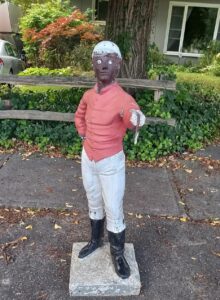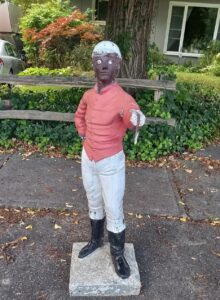Here’s a blast from the past.
This deserted ‘black lawn jockey’ is a sign of a racist past and was photographed on a street in Alderwood.
At one time in the 1950s and 1960s there were many of them decorating suburban and rural yards in Canada and the U.S. They still do in some areas.
It is a symbol that brings back hard feelings for many Black residents and memories of slavery.
Most people today would never think of displaying one.
Experts said the statues were guideposts on the route of the Underground Railroad in the days preceding and during the U.S. Civil War.
Neither underground nor a railroad, the name refers to the series of safe houses from the Deep South to freedom in the northern states and Canada.
Green ribbons were allegedly tied to the arms of the statues to indicate safety, while red ribbons warned of danger and told the escaping slaves’ guide to keep going.
The jockey’s appearance signaled the availability of a place to sleep, a hot meal, or a change of horses. Escaping slaves would watch for telltale markings and patterns on the jockeys’ clothing that provided the roadmaps to safety and survival on the flight to freedom.
Also known as “The Faithful Groomsman,” some historians said it was commissioned by George Washington to honour a young black youth, Jocko Graves, who allegedly froze to death while holding a lantern to guide the American Continental Army safely back to winter barracks at night.
They are also reminders of a shameful period in U.S. history that led not only to the tragedy of civil war, but to the racial hatred and tensions that plague America to this day.

